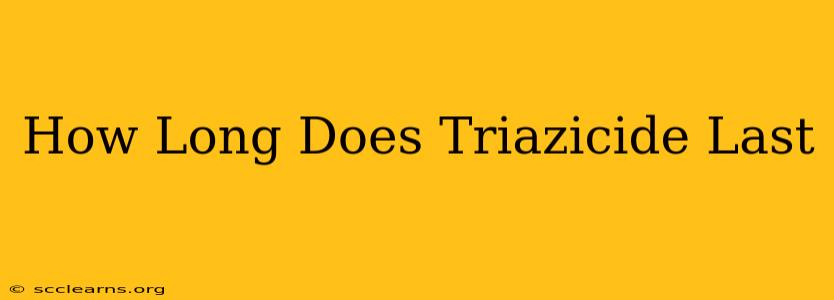Triazicide is a popular insecticide used for controlling a wide range of pests, from ants and fleas to ticks and mosquitoes. But a common question homeowners have is: how long does Triazicide last? The answer isn't simple and depends on several factors. This guide will delve into the longevity of Triazicide, helping you understand its effectiveness and how to maximize its lifespan.
Understanding Triazicide's Residual Effect
Triazicide's effectiveness relies on its residual effect – its ability to remain active and kill pests even after application. This residual period isn't a fixed timeframe; instead, it's influenced by several key elements:
Environmental Factors Impacting Triazicide's Lifespan:
-
Weather Conditions: Rainfall is a major factor. Heavy rain will wash away the Triazicide, significantly shortening its effective lifespan. Sunlight can also break down the active ingredients, reducing its potency. Temperature fluctuations can also influence how long it remains effective.
-
Surface Type: Triazicide's persistence varies depending on the surface it's applied to. Porous surfaces like soil absorb the insecticide faster, resulting in a shorter residual effect compared to non-porous surfaces like concrete or treated wood.
-
Pest Type: Different pests have different sensitivities to Triazicide. Some pests might be killed immediately, while others may require more prolonged exposure. This doesn't necessarily reflect the product's lifespan, but rather the pest's resistance.
Product Formulation: Granules vs. Liquid
The formulation of Triazicide plays a crucial role in its longevity. Granular Triazicide generally lasts longer than liquid formulations. Granules release the active ingredient slowly, providing a more extended residual effect, particularly in soil applications. Liquid sprays, while offering quick knockdown, often require more frequent reapplication.
Typical Lifespan of Triazicide
While a precise timeframe is impossible, here's a general estimate based on typical usage:
-
Outdoor Applications (Granules): Can offer residual control for several weeks, possibly up to a couple of months under ideal conditions (minimal rainfall, moderate temperatures).
-
Outdoor Applications (Liquid): Usually effective for a shorter period, typically one to three weeks, depending heavily on weather conditions.
-
Indoor Applications: The lifespan is typically shorter indoors due to the enclosed environment and potential for cleaning or other disturbances. Expect a residual effect lasting from a few days to a couple of weeks.
Maximizing Triazicide's Effectiveness
To extend Triazicide's lifespan and get the most from your application, consider these tips:
-
Apply according to label instructions: Carefully read and follow the instructions provided on the product label. This ensures you're applying the correct amount and achieving optimal results.
-
Choose the right formulation: Select the Triazicide formulation (granules or liquid) that best suits your needs and the environment.
-
Monitor pest activity: Regularly check for pest activity. Reapply Triazicide when necessary, based on the observed level of infestation and environmental conditions.
-
Protect treated areas from rain: If possible, apply Triazicide when rain isn't expected for at least 24-48 hours.
When to Consider Reapplication
You should consider reapplying Triazicide when you notice:
-
A resurgence of pest activity: If you see more pests than before application, it's time for a reapplication.
-
Heavy rainfall: Heavy rain washes away the insecticide, necessitating reapplication.
-
Extended periods of high heat: Prolonged exposure to high temperatures can also degrade the effectiveness of Triazicide.
Remember: Always prioritize safety. Wear appropriate protective gear during application and store Triazicide properly, out of reach of children and pets. If you have specific concerns or a severe infestation, consider consulting with a pest control professional.

